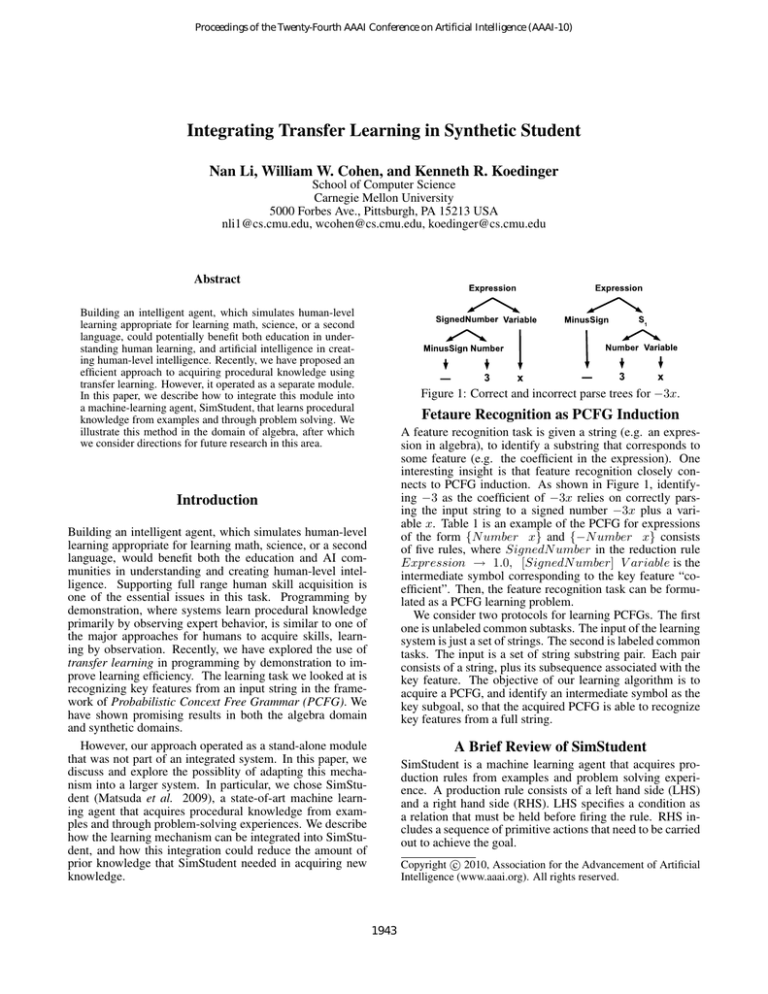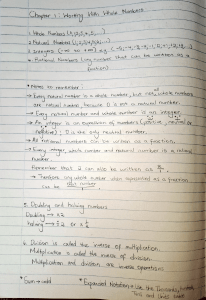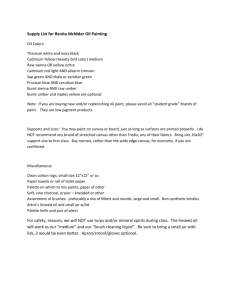
Proceedings of the Twenty-Fourth AAAI Conference on Artificial Intelligence (AAAI-10)
Integrating Transfer Learning in Synthetic Student
Nan Li, William W. Cohen, and Kenneth R. Koedinger
School of Computer Science
Carnegie Mellon University
5000 Forbes Ave., Pittsburgh, PA 15213 USA
nli1@cs.cmu.edu, wcohen@cs.cmu.edu, koedinger@cs.cmu.edu
Abstract
Building an intelligent agent, which simulates human-level
learning appropriate for learning math, science, or a second
language, could potentially benefit both education in understanding human learning, and artificial intelligence in creating human-level intelligence. Recently, we have proposed an
efficient approach to acquiring procedural knowledge using
transfer learning. However, it operated as a separate module.
In this paper, we describe how to integrate this module into
a machine-learning agent, SimStudent, that learns procedural
knowledge from examples and through problem solving. We
illustrate this method in the domain of algebra, after which
we consider directions for future research in this area.
Figure 1: Correct and incorrect parse trees for −3x.
Fetaure Recognition as PCFG Induction
A feature recognition task is given a string (e.g. an expression in algebra), to identify a substring that corresponds to
some feature (e.g. the coefficient in the expression). One
interesting insight is that feature recognition closely connects to PCFG induction. As shown in Figure 1, identifying −3 as the coefficient of −3x relies on correctly parsing the input string to a signed number −3x plus a variable x. Table 1 is an example of the PCFG for expressions
of the form {N umber x} and {−N umber x} consists
of five rules, where SignedN umber in the reduction rule
Expression → 1.0, [SignedN umber] V ariable is the
intermediate symbol corresponding to the key feature “coefficient”. Then, the feature recognition task can be formulated as a PCFG learning problem.
We consider two protocols for learning PCFGs. The first
one is unlabeled common subtasks. The input of the learning
system is just a set of strings. The second is labeled common
tasks. The input is a set of string substring pair. Each pair
consists of a string, plus its subsequence associated with the
key feature. The objective of our learning algorithm is to
acquire a PCFG, and identify an intermediate symbol as the
key subgoal, so that the acquired PCFG is able to recognize
key features from a full string.
Introduction
Building an intelligent agent, which simulates human-level
learning appropriate for learning math, science, or a second
language, would benefit both the education and AI communities in understanding and creating human-level intelligence. Supporting full range human skill acquisition is
one of the essential issues in this task. Programming by
demonstration, where systems learn procedural knowledge
primarily by observing expert behavior, is similar to one of
the major approaches for humans to acquire skills, learning by observation. Recently, we have explored the use of
transfer learning in programming by demonstration to improve learning efficiency. The learning task we looked at is
recognizing key features from an input string in the framework of Probabilistic Concext Free Grammar (PCFG). We
have shown promising results in both the algebra domain
and synthetic domains.
However, our approach operated as a stand-alone module
that was not part of an integrated system. In this paper, we
discuss and explore the possiblity of adapting this mechanism into a larger system. In particular, we chose SimStudent (Matsuda et al. 2009), a state-of-art machine learning agent that acquires procedural knowledge from examples and through problem-solving experiences. We describe
how the learning mechanism can be integrated into SimStudent, and how this integration could reduce the amount of
prior knowledge that SimStudent needed in acquiring new
knowledge.
A Brief Review of SimStudent
SimStudent is a machine learning agent that acquires production rules from examples and problem solving experience. A production rule consists of a left hand side (LHS)
and a right hand side (RHS). LHS specifies a condition as
a relation that must be held before firing the rule. RHS includes a sequence of primitive actions that need to be carried
out to achieve the goal.
c 2010, Association for the Advancement of Artificial
Copyright Intelligence (www.aaai.org). All rights reserved.
1943
ciated with the training problems of the current task to the
recorded frequency from previous tasks.
Table 1: Probabilistic context free grammar for coefficient
in algebra
Integrating Transfer Learning in SimStudent
Primitive symbols: −, x;
Non-primitive symbols: Expression, SignedN umber
V ariable, M inusSign, N umber;
Expression → 1.0, [SignedN umber] V ariable
V ariable → 1.0, x
SignedN umber → 0.5, M inusSign N umber
SignedN umber → 0.5, N umber
M inusSign → 1.0, −
The proposed algorithm only recognizes subsequences from
input as features, and thus is unable to generate characters
from the input. To build a system that models human-level
intelligence, we should extend our system to support not
only feature recognition but also problem solving. Recall
that SimStudent acquires production rules to solve problems. It requires prior knowledge on both the feature predicates and the primitive actions. The feature recognition process described above belongs to the RHS of the production
rule. We could integrate our learning mechanism with SimStudent to enable the power of problem solving. To do this,
we can first call the feature recognition learner to acquire
procedural knowledge for the RHS, so that the production
rule is able to extract important features (i.e. coefficient)
from the problem. We then use the original procedure built
in SimStudent to learn how to transform the original equation into the next step using the key features generated from
the previous steps.
By doing this, since the proposed algorithm does not require any prior knowledge, we have potentially reduced the
amount of knowledge SimStudent needs for future learning. Also, since the proposed algorithm is a transfer learning algorithm, it can easily make use of previously acquired
knowledge to aid later learning. In this case, SimStudent
does not need to remember all previous problems for future
learning, which saves both time and space. Last, we believe
that the proposed feature recognition system can be naturally extended to a sequence generation mechanism. With
that extension, we would be able to fully replace the learning of RHS with the extended algorithm. Then, the learning
system will be able to acquire procedural knowledge without
given prior knowledge on primitive actions.
Prior to learning, SimStudent is given a library of feature
predicates and primitive actions, some of which are generic
and some of which are specialized to the target domain (e.g.,
algebra). To learn from examples, the user needs to demonstrate how to solve problems in a cognitive tutor. For each
step during the demonstration, the user first specifies the focus of atention on the interface. He/she then performs a step,
and labels the demonstrated step with skill name. SimStudent learns a skill by generalizing and/or specializing the
production rule. LHS is acquired by Foil (Quinlan 1990).
RHS is learned by searching the shortest operator sequence
consistent with all previous examples.
Transfer Learning for PCFG
To build our learning model, we extended an existing PCFG
learning algorithm. In particular, we chose the learning
mechanism proposed by Li et al. (Li et al. 2009), since it acquires PCFG from plain strings without any prior structural
knowledge. The system consists of two parts, a greedy structure hypothesizer, which creates non-primitive symbols and
associated reduction rules as needed to cover all the training examples, and a Viterbi training step, which iteratively
refines the probabilities of the reduction rules. We extended
the original algorithm to transfer solutions to common intermediate symbols (features) from one task to another in
accelerating the learning process.
We first consider the situation where the user explicitly
identifies a shared feature for the learner. The original learning algorithm did not make use of this information. Thus, it
sometimes may not be able to learn a grammar that has the
feature symbol embedded in it. However, given the user’s
explicit labeling of one subsequence as fulfilling the common feature, we force the original learner to produce the
desired result by learning the subgrammar for the key feature and acquiring the whole grammar separately. However,
transfer learning in explicitly labeled common features requires extra work for the users. We considered a second
learning protocol, where the shared feature is present, but
not explicitly identified. In this case, two tasks share some
common features that are not labeled by the user. To make
use of previously acquired knowledge, the learner keeps
record of the acquired grammar and the number of times
each grammar rule appeared in a parse tree. When a new
learning task comes in, the learning algorithm first uses the
known grammar to build the smallest number of most probable parse trees for the new records, and then switches to
the original GSH and acquires new rules based on the partially parsed sequences. During the Viterbi training phase,
the learning algorithm adds the applied rule frequency asso-
Conclusion
In this paper, we motivated the research on learner modeling.
We proposed a novel approach that applies transfer learning
in programming by demonstration to improve the accuracy
and the rate of learning. We demonstrated this approach in
the task of recognizing key features from strings. We described how to integrate this learning mechanism into an
integrated agent, SimStudent, and explained how this integration could reduce the amount of prior knowledge needed
to acquire new knowledge.
References
Nan Li, Subbarao Kambhampati, and Sungwook Yoon.
Learning probabilistic hierarchical task networks to capture
user preferences. In Proceedings of the 21st International
Joint Conference on Artificial Intelligence, Pasadena, CA,
2009.
Noboru Matsuda, Andrew Lee, William W. Cohen, and Kenneth R. Koedinger. A computational model of how learner
errors arise from weak prior knowledge. In Proceedings of
Conference of the Cognitive Science Society, 2009.
J. R. Quinlan. Learning logical definitions from relations.
Mach. Learn., 5(3):239–266, 1990.
1944





